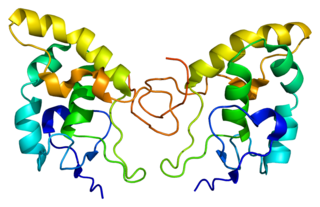| GSDMB | |||||||||||||||||||||||||||||||||||||||||||||||||||
|---|---|---|---|---|---|---|---|---|---|---|---|---|---|---|---|---|---|---|---|---|---|---|---|---|---|---|---|---|---|---|---|---|---|---|---|---|---|---|---|---|---|---|---|---|---|---|---|---|---|---|---|
| Identifiers | |||||||||||||||||||||||||||||||||||||||||||||||||||
| Aliases | GSDMB , GSDML, PRO2521, PP4052, gasdermin B, GSDMB-1 | ||||||||||||||||||||||||||||||||||||||||||||||||||
| External IDs | OMIM: 611221; HomoloGene: 88856; GeneCards: GSDMB; OMA:GSDMB - orthologs | ||||||||||||||||||||||||||||||||||||||||||||||||||
| |||||||||||||||||||||||||||||||||||||||||||||||||||
| |||||||||||||||||||||||||||||||||||||||||||||||||||
| |||||||||||||||||||||||||||||||||||||||||||||||||||
| |||||||||||||||||||||||||||||||||||||||||||||||||||
| Wikidata | |||||||||||||||||||||||||||||||||||||||||||||||||||
| |||||||||||||||||||||||||||||||||||||||||||||||||||
Gasdermin B is a protein that in humans is encoded by the GSDMB gene. [3]
| GSDMB | |||||||||||||||||||||||||||||||||||||||||||||||||||
|---|---|---|---|---|---|---|---|---|---|---|---|---|---|---|---|---|---|---|---|---|---|---|---|---|---|---|---|---|---|---|---|---|---|---|---|---|---|---|---|---|---|---|---|---|---|---|---|---|---|---|---|
| Identifiers | |||||||||||||||||||||||||||||||||||||||||||||||||||
| Aliases | GSDMB , GSDML, PRO2521, PP4052, gasdermin B, GSDMB-1 | ||||||||||||||||||||||||||||||||||||||||||||||||||
| External IDs | OMIM: 611221; HomoloGene: 88856; GeneCards: GSDMB; OMA:GSDMB - orthologs | ||||||||||||||||||||||||||||||||||||||||||||||||||
| |||||||||||||||||||||||||||||||||||||||||||||||||||
| |||||||||||||||||||||||||||||||||||||||||||||||||||
| |||||||||||||||||||||||||||||||||||||||||||||||||||
| |||||||||||||||||||||||||||||||||||||||||||||||||||
| Wikidata | |||||||||||||||||||||||||||||||||||||||||||||||||||
| |||||||||||||||||||||||||||||||||||||||||||||||||||
Gasdermin B is a protein that in humans is encoded by the GSDMB gene. [3]
This gene encodes a member of the gasdermin-domain containing protein family. Other gasdermin-family genes are implicated in the regulation of apoptosis in epithelial cells, and are linked to cancer. Multiple transcript variants encoding different isoforms have been found for this gene. Additional variants have been described, but they are candidates for nonsense-mediated mRNA decay (NMD) and are unlikely to be protein-coding.
GSDMB expression has been linked to higher survival rates for lung cancer patients. [4]

Frizzled-8(Fz-8) is a protein that in humans is encoded by the FZD8 gene.

Frizzled-10(Fz-10) is a protein that in humans is encoded by the FZD10 gene. Fz-10 has also been designated as CD350.

Proto-oncogene protein Wnt-3 is a protein that in humans is encoded by the WNT3 gene.

Transcription factor RFX4 is a protein that in humans is encoded by the RFX4 gene.

Protein Wnt-2b is a protein that in humans is encoded by the WNT2B gene.

UBX domain-containing protein 11 is a protein that in humans is encoded by the UBXN11 gene.

Protein Wnt-16 is a protein that in humans is encoded by the WNT16 gene. It has been proposed that stimulation of WNT16 expression in nearby normal cells is responsible for the development of chemotherapy-resistance in cancer cells.

Tyrosine-protein kinase-like 7 also known as colon carcinoma kinase 4 (CCK4) is a receptor tyrosine kinase that in humans is encoded by the PTK7 gene.

Formin-like protein 2 is a protein that in humans is encoded by the FMNL2 gene.

Syntaxin-binding protein 5 is a protein that in humans is encoded by the STXBP5 gene. It is also known as tomosyn, after 友, "friend" in Japanese, for its role as a binding protein.

WD repeat-containing protein 11 (WDR11) also known as bromodomain and WD repeat-containing protein 2 (BRWD2) is a protein that in humans is encoded by the WDR11 gene.

DnaJ homolog subfamily C member 11 is a protein that in humans is encoded by the DNAJC11 gene.

PR domain zinc finger protein 9 is a protein that in humans is encoded by the PRDM9 gene. PRDM9 is responsible for positioning recombination hotspots during meiosis by binding a DNA sequence motif encoded in its zinc finger domain. PRDM9 is the only speciation gene found so far in mammals, and is one of the fastest evolving genes in the genome.

Hes family bHLH transcription factor 2 is a protein that in humans is encoded by the HES2 gene.

Hes family bHLH transcription factor 3 is a protein that in humans is encoded by the HES3 gene.

Gasdermin A is a protein that in humans is encoded by the GSDMA gene.

Prickle planar cell polarity protein 1 is a protein that in humans is encoded by the PRICKLE1 gene.

GEN1, Holliday junction 5' flap endonuclease is a protein that in humans is encoded by the GEN1 gene.

StAR related lipid transfer domain containing 3(STARD3) is a protein that in humans is encoded by the STARD3 gene. STARD3 also known as metastatic lymph node 64 protein (MLN64) is a late endosomal integral membrane protein involved in cholesterol transport. STARD3 creates membrane contact sites between the endoplasmic reticulum (ER) and late endosomes where it moves cholesterol.

Family with sequence similarity 13 member B is a protein which in humans is encoded by the FAM13B gene, also known as C5ORF5. The FAM13B gene is found in vertebrates and jawed fish. FAM13B is expressed ubiquitously in human tissues and has been linked to maglinant myelomas susceptibility to atrial fibrillation, a cardiac arrhythmia.
This article incorporates text from the United States National Library of Medicine, which is in the public domain.